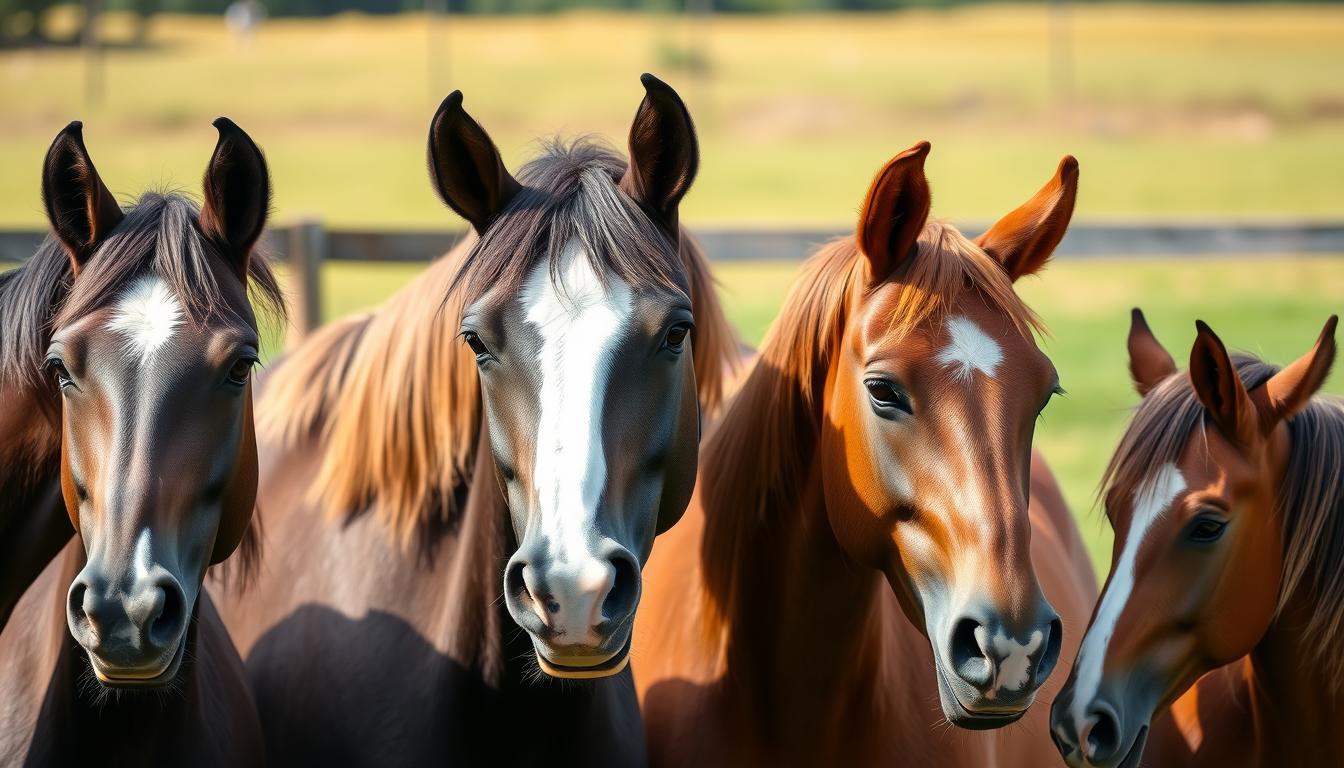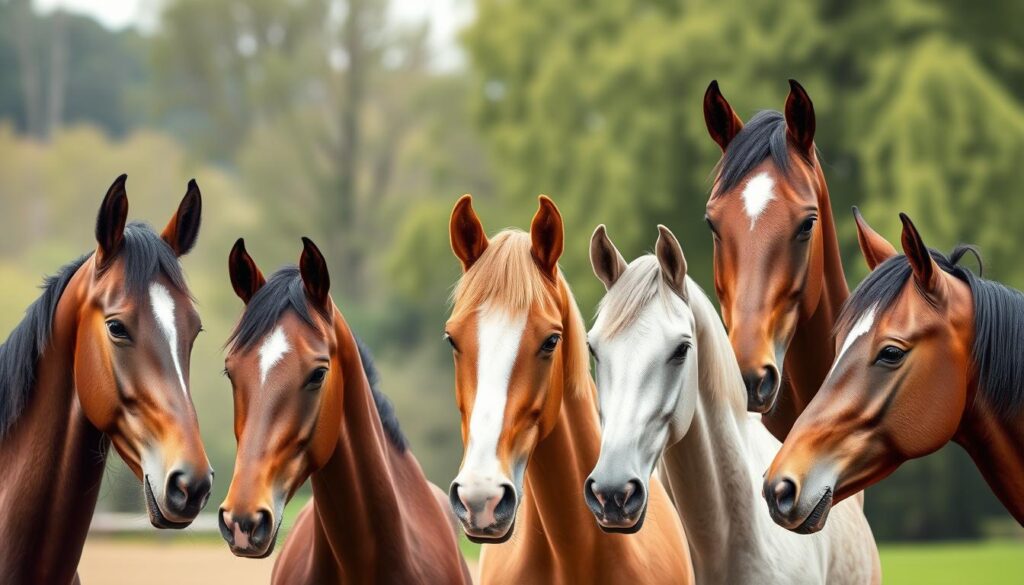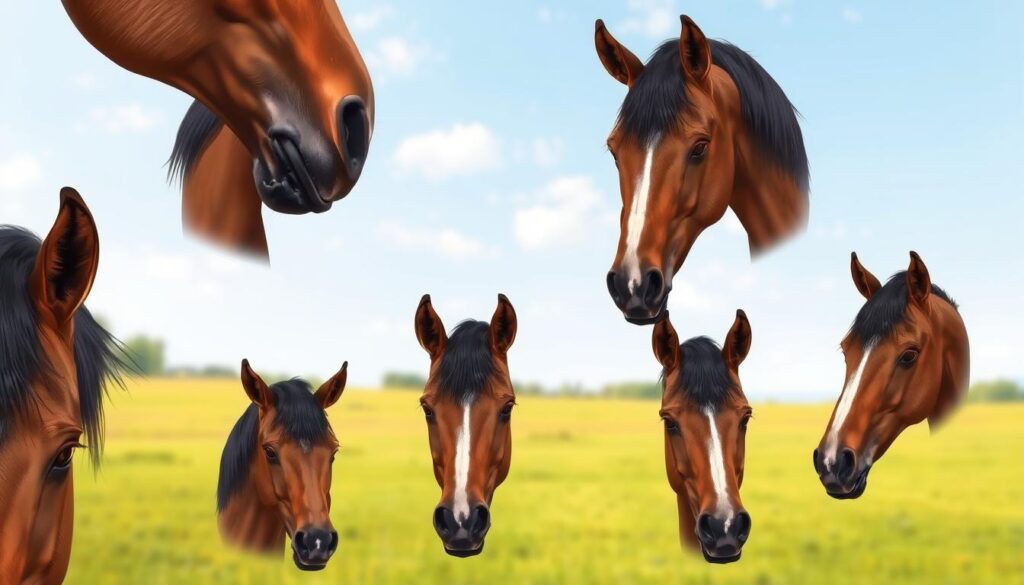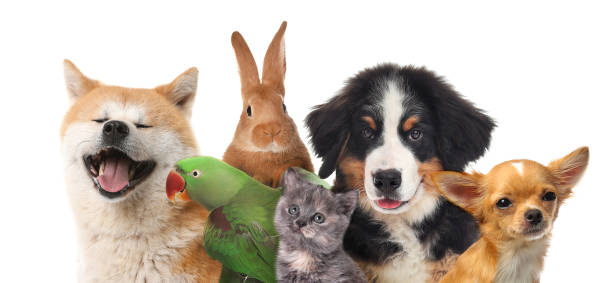Understanding Horse Ear Shapes and Their Meanings

Did you know horses can move their ears to hear sounds a mile away? This amazing skill shows how important horse ear shapes are. They help us understand a horse’s mood and behavior12. Exploring horse ear anatomy reveals these ears are key for communication. Each ear movement tells us about their feelings.
Knowing about horse ear shapes is key for anyone who loves horses. It helps you connect better with your horse. We’ll look at how ear positions show emotions like calmness or anger. This knowledge improves how we talk to our horses.
Key Takeaways
- Horse ear shapes play a critical role in understanding equine emotions.
- Different ear positions offer insights into various moods such as alertness, relaxation, or fear.
- Horses can swivel their ears in 180 degrees for optimal hearing.
- Recognizing ear shapes can enhance your relationship with your horse.
- Awareness of ear movements helps prevent misunderstandings and miscommunication.
Introduction to Equine Communication
Understanding how horses communicate is key for anyone who works with them. Horses use body language to show their feelings and plans. This includes ear positions, mouth movements, and eye expressions.
Horses have ten muscles in each ear, letting them move almost 180 degrees. This helps them hear sounds from far away3. They can hear sounds from 14 Hz to 25 kHz, while humans can only hear from 20 Hz to 20 kHz4.
Ear movements tell a lot about a horse’s mood. They can show if a horse is curious, angry, or relaxed. Anxious horses find loud places and tense atmospheres overwhelming.
The position of a horse’s ears shows its emotional state. It can be alert, curious, attentive, tense, relaxed, or aggressive. Mares are more aware of their surroundings than geldings or stallions, showing their knowledge through ear movements3.
Knowing these signals helps you interact better with horses. It keeps you safe and shows you care. By understanding their body language, you build trust and understanding with them.
The Importance of Horse Ear Anatomy
Studying horse ear anatomy gives us key insights into how horses communicate. Knowing about horse ear characteristics helps us connect better with them. Horses have special features that let them hear a wide range of sounds. This is important for their survival and social life.
Horses have ten muscles around their outer ears, unlike humans with only three. This lets horses move their ears almost 180 degrees. They can find sound sources easily. Each ear type plays a role in their hearing.
The equine ear is divided into outer, middle, and inner parts, each with its own job. The middle ear has the smallest bones in the body, which help amplify sound. Horses also don’t have hair in their lower ear canal. This helps keep their ears clean and healthy.
| Ear Structure | Function |
|---|---|
| Outer Ear | Gathers sound waves and channels them to the eardrum. |
| Middle Ear | Contains ossicles that amplify sound vibrations. |
| Inner Ear | Translates vibrations into nerve signals for hearing. |
Knowing about horse ear types helps us understand their behavior. It’s crucial for training and building a strong bond with them. Learning about horse ear anatomy lets us connect more deeply with these amazing animals567.
Different Horse Ear Shapes and Their Characteristics
It’s important to know about the different horse ear shapes. They help horses communicate and react to their surroundings. Each ear shape and size is unique and affects a horse’s behavior and mood. For example, cold-blooded horses have fleshy ears, while warm-blooded ones have lighter ears8.
Common ear shapes include:
- Erect Ears: Show alertness and curiosity, pointing forward when a horse is interested.
- Floppy Ears: Mean a horse is relaxed and feels safe.
- Rounded Ears: Show a mix of relaxation and caution, indicating a horse is aware but not scared.
Ear characteristics also show a horse’s emotions. For instance, anxious horses may have ears pointing in different directions and tense muscles9. On the other hand, a horse ready to flee will lean back and turn away from danger9. This shows how vital ear shapes and movements are in horse communication.
By noticing the different horse ear shapes, you can understand your horse better. For more on equine communication, check out this informative article that explores how horses use their ears to communicate9.
Identifying Horse Ear Positions

Understanding horse ear positions is key to reading equine emotions. Different ear positions show various feelings, from alertness to aggression. For example, ears up and forward mean the horse is interested and focused.
On the other hand, ears pinned back show discomfort or irritation. This often means the horse feels threatened or aggressive10.
A detailed horse ear shapes guide helps spot these subtle signs. Horses use ear movements to talk to each other and to humans. Ears that flick a lot might mean the horse is anxious or distracted.
But, if a horse’s ears are relaxed and flat, it’s likely feeling calm or comfortable11.
Knowing about horse ear types improves how we interact with them. Studies show horses behave differently based on whether they think we’re paying attention. For instance, if a horse sees someone watching, it’s more likely to come over for food11.
In situations like feeding or training, a horse’s ear position greatly affects its response to cues. It’s crucial to watch these ear positions closely for better communication and understanding of the horse’s mood here.
| Ear Position | Indication |
|---|---|
| Forward | Interest or curiosity |
| Pinned Back | Anger or aggression |
| Flicked | Agitation or attentiveness |
| Relaxed | Calm or comfortable |
By focusing on your horse’s ear positions, you can understand its mood and how it might react. Knowing these signs is essential for better equine handling. It helps create a more harmonious bond between you and your horse11.
Understanding Horse Ear Shapes and Their Meanings
Horse ears tell us a lot about their feelings and actions. Knowing what their ear shapes mean can make our time with them better and safer. Different ear positions show if a horse is curious, comfortable, or upset.
Alertness Indicators
When a horse’s ears point up, it means they’re curious and alert. This shows they’re ready to notice and react to things around them. Horses can turn their ears up to 180 degrees to listen in different directions12.
Relaxed Ear Positions
If a horse’s ears droop or hang down, it’s a sign they’re relaxed and feel safe. This tells us they’re enjoying the moment. A horse with relaxed ears is usually easier to approach and safer to be around.
Signs of Aggression or Fear
Flat ears mean a horse might be feeling aggressive or scared13. It’s a warning sign that they might defend themselves or feel uncomfortable. It’s best to be careful and not rush towards a horse showing these signs to keep everyone safe.
How Ear Shapes Reflect Horse Temperament
The link between ear shapes and horse temperament is quite interesting. Knowing this can help you better understand horse behavior. A horse’s ear shape and position can give clues about its genetics and behavior.
The Role of Genetics in Ear Shape and Temperament
Genetics greatly affect ear shape, which is linked to horse temperament. For example, how a horse’s ears are placed can influence its behavior. Horses with certain ear shapes may show specific traits. Research shows that horses with nice head and ear shapes are more likely to be calm and easier to train14.
Behavioral Observations Related to Ear Shapes
Watching a horse’s ear positions can tell you a lot about its mood. If a horse’s ears are relaxed and forward, it’s likely calm. But if its ears are pinned back, it might be scared or angry. A study on Lipizzan horses found that those that were cooperative often had ear shapes that followed certain lines15. Watching how a horse’s ears move can help you understand its behavior better.
Interpreting Ear Movements in Different Situations
Understanding ear movements is key for good horse communication. Horses use their ears to show emotions and plans. Studies show that 100% of horses use body language, with ears playing a big role16. When ears point forward, it means the horse is curious or alert17.
Watch your horse’s ears during riding or grazing. Ears laid flat can mean the horse is dominant or ready to react17. But if ears are relaxed and sideways, it shows trust and happiness17. If one ear is cocked back, the horse is listening to something or divided its attention17.
Knowing your horse’s signals is important. For example, if a horse’s ears flick a lot, it might be anxious or alert17. This can happen in stressful places, like a competition. Also, if a horse’s ears point back while riding, it might be showing resistance or discomfort16.
Learning to read these signals can strengthen your bond with your horse. Knowing when and why your horse’s ears move helps you meet its needs better.
Common Misconceptions about Horse Ear Positions

Understanding horse ears is key to reading their behavior. Many horse ear misconceptions lead to equine behavior misunderstandings. These can confuse horse owners and riders. For example, some think all backward ear positions mean fear or anger. But, horses often turn their ears towards sounds they find interesting, not because they’re scared.
Another myth is that ears pinned back always show a negative emotion. But, this can also mean a horse is focused or concentrating. Like when they’re racing barrels or jumping. Horses move their ears to talk to each other or to humans, showing if they’re comfortable or paying attention.
It’s important to understand these subtleties for better horse care and training. Misreading these signs can lead to horse communication myths that make it hard to connect with your horse. Learning from trusted sources can clear up these myths. This way, you’ll get a deeper understanding of your horse’s behavior. For more information, visit this resource18.
Conclusion
Understanding horse ear shapes is key to better communication with them. Each horse has unique ears that show their feelings and alertness. By watching their ears, you can see how they’re doing, which is great for handling them safely and building trust.
This article shows how important it is to notice these small signs. Horses can hear from 55 to 33,500 Hertz, using their ears to talk and show feelings19. Knowing this can make your time with horses better, leading to safer and more effective training.
By using this knowledge every day, you can connect deeper with your horse. Whether you’re in a busy place or just hanging out, paying attention to their ears can change how you interact with them. For more info on horse ears and hearing, check out this resource that goes into their hearing and how they communicate2021.
FAQ
Why is understanding horse ear shapes important?
What are the main types of horse ear shapes?
How can I tell what my horse is feeling based on their ear positions?
Are ear shapes related to a horse’s genetics?
What are some myths about horse ear positions?
How do I interpret ear movements while riding?
What characteristics should I look for in horse ear anatomy?
How can I improve my communication with my horse using ear shapes and positions?
Source Links
- https://www.yourhorse.co.uk/horse-care/horse-behaviour/horse-ear-positions/ – What do a horse’s ear positions mean?
- https://www.petmd.com/horse/how-read-horses-body-language – How to Read a Horse’s Body Language
- https://herthamuddyhorse.com/2024/04/01/reading-ears/ – Reading Ears
- https://esc.rutgers.edu/fact_sheet/the-basics-of-equine-behavior/ – The Basics of Equine Behavior
- https://en.wikivet.net/Equine_Ear_-_Horse_Anatomy – Equine Ear – Horse Anatomy
- https://pmc.ncbi.nlm.nih.gov/articles/PMC7509108/ – Sensory Abilities of Horses and Their Importance for Equitation Science
- https://equinewellnessmagazine.com/horses-eyes-ears/ – Understanding your horse’s eyes and ears
- https://www.equishop.com/en/blog/horse-anatomy-body-parts-muscles-skeleton-n299 – Horse anatomy – diagrams of horse body parts
- https://www.rspca.org.uk/adviceandwelfare/pets/horses/behaviour/bodylanguage – Understanding Your Horse’s Body Language | RSPCA – RSPCA – rspca.org.uk
- https://www.petplanequine.co.uk/bodylanguage/ – Horse Body Language | Petplan Equine
- https://link.springer.com/article/10.1007/s10071-024-01909-y – Exploring horses’ (Equus caballus) gaze and asymmetric ear position in relation to human attentional cues – Animal Cognition
- https://www.arabianessence.tv/posts/blog/blog/a-sketch-study-of-the-arabian-face-the-ears/11143 – A sketch study of the Arabian Face: the Ears. | Arabian Essence TV
- https://thehorse.com/1122420/handling-the-head-shy-horse/ – Handling the Head-Shy Horse
- https://horses.extension.org/relating-form-to-function-horses-head/ – Relating Form to Function: Horse’s Head
- https://www.nature.com/articles/s41598-022-16627-z – Relationship between anatomical characteristics and personality traits in Lipizzan horses – Scientific Reports
- https://fallingstarranch.wordpress.com/2013/11/19/equine-body-language-part-1-what-is-your-horse-telling-you/ – Equine body language (part 1): What is your horse telling you?
- https://www.horseillustrated.com/horse-ear-position?srsltid=AfmBOop6UgpHwcq-6a3ROuL3DDIePCPhyKNLcRxcuLMEhEx4vGwy65K4 – What Does Your Horse’s Ear Position Tell You?
- https://barrelhorsenews.com/barrel-racing-articles/training-40510/subtle-adjustments/ – Subtle Adjustments – Barrel Horse News
- https://www.malgretoutmedia.com/professional/10-facts-about-a-horses-ears-and-hearing/ – 10 facts about a horse’s ears and hearing | Malgré Tout Media
- https://www.scientificamerican.com/article/ears-do-their-design-size-and-shape-matter/ – Ears: Do Their Design, Size and Shape Matter?
- https://mink-studios.blogspot.com/2016/10/equine-anatomy-and-biomechanics-primer.html – Equine Anatomy and Biomechanics: A Primer of Equine Engineering Part VIII, The Head



